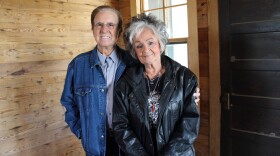After years of fundraising and restoration work, Johnny Cash’s boyhood home in northeast Arkansas will officially open to the public Saturday as a museum.
The country music icon – who died 11 years ago – moved to the house in 1935 when he was three years old. His family was one of about 500 selected to live in the town of Dyess, which was created during the Great Depression as part of President Franklin Roosevelt's New Deal. They were sold a piece of farm land at a low price in return for making contributions to the community.
Arkansas State University bought the house several years ago as part of its Arkansas Heritage Sites program. At that time it was dilapidated and some modifications had been made to the home, but Ruth Hawkins, director of the program, says when they began restoration work, they were pleased with what they found buried under layers of linoleum or wallpaper.
"The biggest surprise to us was, because it was in such bad shape when we got it, we assumed that there was not a lot left of the original material in the house. But as we got into it, we found, I would say that probably 75 to 80 percent of the original material is there," Hawkins said. That includes the original wooden floor and wood panel walls, which she says the Cash family never painted during nearly two decades there.
Johnny Cash often spoke about the influence his childhood there had on him. During a 1969 concert at New York's Madison Square Garden, he said, "After I got into the music field, I started writing, recording and singing songs about the things I knew. I wrote a lot of songs about life as I knew it back when I was a little bitty boy."
One of his early hit songs was "Five Feet High and Rising," based on a 1937 flood of the nearby Mississippi River, which forced an evacuation of Dyess.
Cash's parents sold the house in the 1950s and it was lived in by different people until recently being purchased by ASU.

Among the biggest challenges of the restoration was fixing the foundation. Hawkins says it was built on gumbo soil, which would shift, causing the home to become unlevel. By the time a ceremony was held to mark the beginning of the restoration on February 26, 2012, the house had been lifted up and placed on the back of a trailer so that a deep concrete foundation could be poured in the ground. It was eventually buried by a layer of soil and the home put back in place.
Much of the money for the project has been raised through a series of benefit concerts, with the first show being held in 2011. The fourth annual show is set for Friday night at the ASU Convocation Center, this year featuring Loretta Lynn, Bobby Bare and Reba McEntire.
The museum at the house and the Dyess Administration building will not only look at Cash’s life, but also the unique history of the town.
U.S. Senator John Boozman of Arkansas got an advance tour of the home Wednesday, while passing through the area.
"I’m a history fan," Boozman said. "You had 500 families move there during the Depression that literally had nowhere else to go, so that combined with being a Johnny Cash fan, it really is just a great thing that I’m so glad we’ve saved for the future."
Saturday's grand opening will include members of the Cash family, including Johnny's brother Tommy and sister Joanne, who worked with ASU during the restoration to help them bring it back to the way it looked when they lived there. Johnny's daughter Rosanne Cash, who has also had an accomplished career as a singer, is also expected to take part.
She said her visits to Arkansas to view progress of the restoration inspired her to write several songs that were included in her album The River & The Thread, which was released in January.
In an interview with KUAR in November 2013, she said "My dad was always incredibly proud of where he came from and it was always a real part of who he was and his persona in the world was that he was from Arkansas, he was raised on a cotton farm."
"Coming back to that when we started the restoration of his boyhood home and seeing really what that meant, how far he walks from the house to school, how big the land was that they farmed, how hard the life was. It really gave me a whole new level of respect and understanding, even though I thought that I’d understood that, just to see the tangible remnants of that, like these things that they have here, it makes quite an impact. It helps you know who you are if you know who your parents really were," Rosanne Cash said.
Those interested in visiting the Johnny Cash boyhood home can learn more here.








